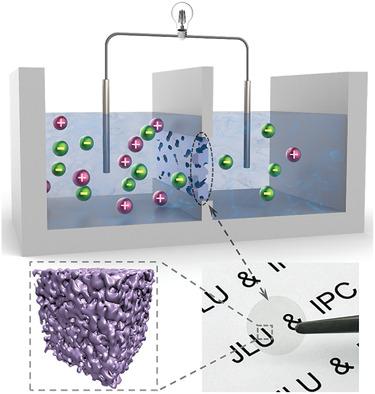当前位置:
X-MOL 学术
›
Adv. Energy Mater.
›
论文详情
Our official English website, www.x-mol.net, welcomes your
feedback! (Note: you will need to create a separate account there.)
Polymeric Nano‐Blue‐Energy Generator Based on Anion‐Selective Ionomers with 3D Pores and pH‐Driving Gating
Advanced Energy Materials ( IF 24.4 ) Pub Date : 2020-09-30 , DOI: 10.1002/aenm.202001552 Xuanbo Zhu 1 , Jundong Zhong 1 , Junran Hao 2, 3 , Yuzhang Wang 3 , Jiajia Zhou 3 , Jingwen Liao 4 , Yujie Dong 5 , Jinhui Pang 1 , Haibo Zhang 1 , Zizhun Wang 6 , Wei Zhang 6 , Weitao Zheng 6 , Zhenhua Jiang 1 , Yahong Zhou 2 , Lei Jiang 2, 3
Advanced Energy Materials ( IF 24.4 ) Pub Date : 2020-09-30 , DOI: 10.1002/aenm.202001552 Xuanbo Zhu 1 , Jundong Zhong 1 , Junran Hao 2, 3 , Yuzhang Wang 3 , Jiajia Zhou 3 , Jingwen Liao 4 , Yujie Dong 5 , Jinhui Pang 1 , Haibo Zhang 1 , Zizhun Wang 6 , Wei Zhang 6 , Weitao Zheng 6 , Zhenhua Jiang 1 , Yahong Zhou 2 , Lei Jiang 2, 3
Affiliation

|
Blue energy as a renewable, substantial energy resource has attracted scientists who are interested in discovering abundant membrane materials to achieve high power density. For decades, ionomers have been used as ion‐exchange membrane to harvest this energy. Though extensive studies have been conducted, the underlying mechanism of ionic transmembrane behavior is still under debate. Here, the ionic transmembrane properties through membranes with 3D pores prepared by ionomers (polyphenylsulphone with pyridine pendants (PPSU‐Py)) are systematically studied. A series of PPSU‐Py with tunable porosities and surface charge densities is obtained simply by adjusting the percentages of the pendant. Nanoscale morphologies of the ionomers are simulated with the dissipative particle dynamic method, which is in agreement with the experimental data. Then, nanofluidic behaviors of as‐prepared porous membranes are studied, which exhibit anion selectivity, pH gating, and modulated transmembrane conductance. Furthermore, a series of salinity gradient power harvesters based on the ionomers are constructed, of which the output power density is improved by tuning the charge density with the maximum output power density that reaches up to 1.44 W m‐2. The impact of the ionomer on nanofluidic behavior is systematically discussed, and it is believed this work will shed light on nanofluidic materials and blue energy generator design.
中文翻译:

基于具有3D孔和pH驱动门的阴离子选择性离聚物的聚合物纳米蓝能量发生器
蓝色能源作为一种可再生的重要能源,吸引了对发现丰富的膜材料以实现高功率密度感兴趣的科学家。几十年来,离聚物已被用作离子交换膜来收集这种能量。尽管已进行了广泛的研究,但离子跨膜行为的潜在机制仍在争论中。在这里,系统地研究了由离聚物(带有吡啶侧基的聚苯砜(PPSU-Py))制备的具有3D孔的膜的离子跨膜特性。只需调节悬垂物的百分比即可获得一系列具有可调孔隙率和表面电荷密度的PPSU-Py。用耗散粒子动力学方法模拟了离聚物的纳米级形貌,这与实验数据吻合。然后,研究了制备的多孔膜的纳米流体行为,这些行为表现出阴离子选择性,pH门控和调节的跨膜电导。此外,构建了一系列基于离聚物的盐度梯度功率收集器,通过调节电荷密度使最大输出功率密度达到1.44 W m,从而提高了输出功率密度。‐2。系统地讨论了离聚物对纳米流体行为的影响,相信这项工作将为纳米流体材料和蓝色能量发生器的设计提供启示。
更新日期:2020-11-25
中文翻译:

基于具有3D孔和pH驱动门的阴离子选择性离聚物的聚合物纳米蓝能量发生器
蓝色能源作为一种可再生的重要能源,吸引了对发现丰富的膜材料以实现高功率密度感兴趣的科学家。几十年来,离聚物已被用作离子交换膜来收集这种能量。尽管已进行了广泛的研究,但离子跨膜行为的潜在机制仍在争论中。在这里,系统地研究了由离聚物(带有吡啶侧基的聚苯砜(PPSU-Py))制备的具有3D孔的膜的离子跨膜特性。只需调节悬垂物的百分比即可获得一系列具有可调孔隙率和表面电荷密度的PPSU-Py。用耗散粒子动力学方法模拟了离聚物的纳米级形貌,这与实验数据吻合。然后,研究了制备的多孔膜的纳米流体行为,这些行为表现出阴离子选择性,pH门控和调节的跨膜电导。此外,构建了一系列基于离聚物的盐度梯度功率收集器,通过调节电荷密度使最大输出功率密度达到1.44 W m,从而提高了输出功率密度。‐2。系统地讨论了离聚物对纳米流体行为的影响,相信这项工作将为纳米流体材料和蓝色能量发生器的设计提供启示。











































 京公网安备 11010802027423号
京公网安备 11010802027423号